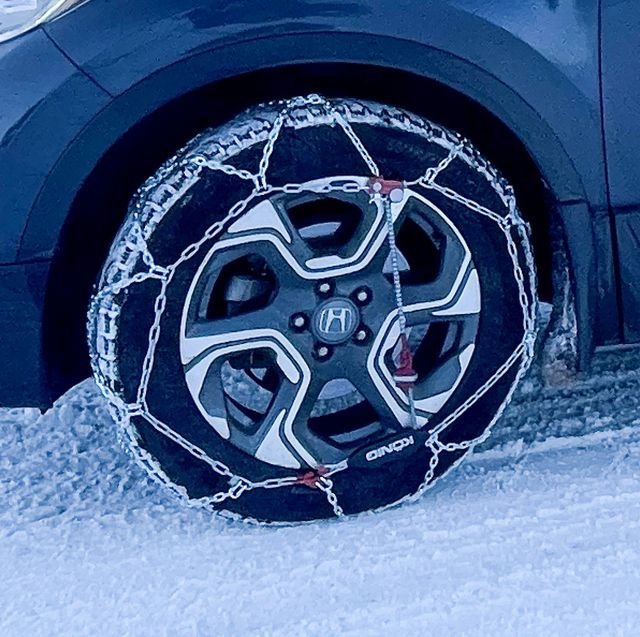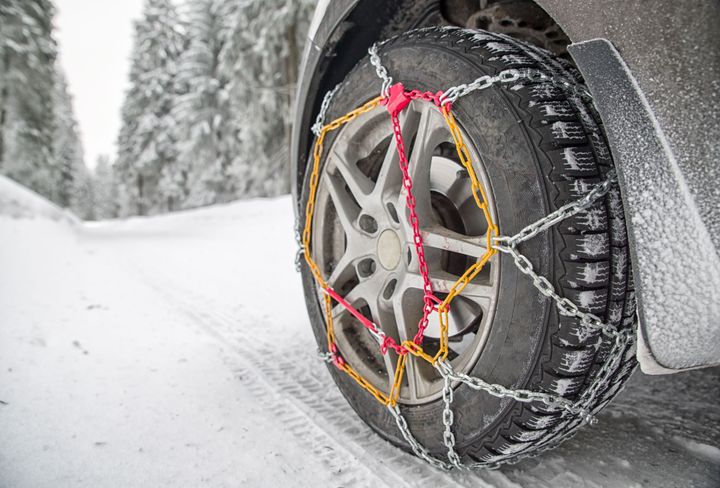


Driving in winter conditions can be a daunting task, but with the right preparation and equipment, you can navigate snowy and icy roads safely. This comprehensive guide will delve into the importance of using tire chains on all-wheel-drive (AWD) vehicles, providing valuable insights into proper installation techniques, alternative traction devices, winter driving safety practices, and legal considerations.

All-wheel drive (AWD) systems distribute power to all four wheels, enhancing traction and control on slippery surfaces. However, even with AWD, additional measures like tire chains may be necessary to achieve optimal grip on snow and ice-covered roads. This guide will explore the various aspects of using tire chains on AWD vehicles, ensuring you have the knowledge to tackle winter driving conditions with confidence.
For AWD vehicles, it is generally recommended to install tire chains on all four tires. This practice ensures balanced traction distribution, minimizing the risk of unequal grip between the front and rear wheels. By maintaining even traction, the chances of skidding or losing control are significantly reduced.
| Benefit | Description |
|---|---|
| Balanced Traction | Installing chains on all four tires ensures even traction distribution across the vehicle. |
| Reduced Skidding | With balanced traction, the risk of skidding or losing control is minimized. |
| Improved Control | Even traction distribution enhances overall control and handling of the vehicle. |
While most vehicle manufacturers recommend using tire chains on all four tires for AWD models, it's essential to consult your owner's manual for any specific recommendations or exceptions. Some manufacturers may have unique guidelines or limitations regarding tire chain usage on their AWD vehicles.
Proper installation and removal of tire chains are crucial for their effectiveness and safety. Follow these steps for a seamless process:
Before installing tire chains, find a safe and level area to park your vehicle, away from traffic. Ensure you have the correct size chains for your tires and follow the manufacturer's instructions carefully.
Preparation:
Park in a safe, level area away from traffic
Ensure you have the correct size chains for your tires
Read and understand the manufacturer's instructions
Tensioning and securing chains:
Proper tensioning and securing of the chains are crucial for their effectiveness and safety
Chains that are too loose can come off or cause damage
Overtightened chains can strain the vehicle's suspension components
Once you reach clear roads, remove the tire chains as soon as possible to prevent unnecessary wear and tear on your vehicle. Follow the manufacturer's instructions for safe removal and storage of the chains.
Remove chains promptly when reaching clear roads
Follow manufacturer's instructions for safe removal
Properly store the chains for future use
When driving with tire chains installed, it's essential to reduce your speed and exercise caution. Chains can affect handling and braking, so adjust your driving accordingly.
| Safety Precaution | Description |
|---|---|
| Reduce Speed | Chains can affect handling and braking, so reduce your speed accordingly. |
| Exercise Caution | Drive cautiously and be prepared for changes in road conditions. |
| Practice Installation | Practice installing and removing the chains in dry conditions before attempting it in winter weather. |
Additionally, practice installing and removing the chains in dry conditions before attempting it in winter weather.
While traditional tire chains are effective, alternative traction devices like cable chains or autosocks offer convenience and potentially less damage to your vehicle's wheels or suspension components. However, these options may not provide the same level of traction as traditional chains in extreme winter conditions.
| Traction Device | Advantages | Disadvantages |
|---|---|---|
| Cable Chains | - Easier to install and remove - Less damage to wheels and suspension | - May not provide as much traction as traditional chains in extreme conditions |
| Autosocks | - Convenient and easy to use - Reusable and compact for storage | - Limited lifespan compared to chains - May not perform well in deep snow or ice |
When considering alternative traction devices, weigh the pros and cons based on your specific driving needs and the severity of the winter conditions you expect to encounter.
Even with AWD and tire chains, it's crucial to drive cautiously and adjust your speed according to the road conditions. Winter driving can be unpredictable, and maintaining a safe following distance, braking early, and being prepared for sudden changes in road conditions are essential.

Adjust speed according to road conditions
Maintain a safe following distance
Brake early and gradually
Be prepared for sudden changes in road conditions
Additionally, it's recommended to carry emergency supplies in your vehicle, such as:
Shovel
Sand or cat litter for traction
Flashlight
Warm clothing
Fully charged phone
First aid kit
Non-perishable snacks and water
Having these essential items on hand can help you stay safe and prepared in case of an emergency or unexpected situation while driving in winter conditions.
Many states and local jurisdictions have laws and regulations regarding the use of tire chains or traction devices. Some areas may have specific requirements or restrictions, such as designated chain-up areas or speed limits when chains are installed.
| Regulation | Description |
|---|---|
| Chain-up Areas | Some areas may have designated chain-up areas where tire chains must be installed. |
| Speed Limits | Reduced speed limits may be enforced when driving with tire chains installed. |
| Fines and Penalties | Failure to comply with local regulations can result in fines or penalties. |
Before embarking on a winter journey, familiarize yourself with the relevant laws and regulations in the areas you'll be traveling through to ensure compliance and avoid potential fines or penalties.
Navigating winter roads with an AWD vehicle can be safer and more manageable with the proper use of tire chains or alternative traction devices. By following the recommendations outlined in this guide, you can ensure balanced traction, proper installation and removal techniques, and adherence to legal requirements. Remember, even with the best traction aids, driving cautiously and being prepared for winter conditions is paramount for a safe and enjoyable journey.
It is generally recommended to install tire chains on all four tires of an AWD vehicle. This ensures balanced traction distribution and reduces the risk of skidding or losing control.
Proper tensioning of tire chains is crucial - chains that are too loose can come off or cause damage, while overtightened chains can strain the vehicle's suspension components.
You should remove tire chains promptly once you reach clear roads to prevent unnecessary wear and tear on your vehicle.
Cable chains and autosocks are alternative traction devices that may be easier to install and remove, but may not provide as much traction as traditional chains in extreme conditions.
When driving with tire chains installed, you should reduce your speed and exercise caution, as chains can affect handling and braking.
It is recommended to carry a shovel, sand or cat litter, flashlight, warm clothing, fully charged phone, first aid kit, and non-perishable snacks and water.
Many areas have laws and regulations regarding the use of tire chains or traction devices, and failure to comply can result in fines or penalties.
Common regulations include designated chain-up areas where chains must be installed, reduced speed limits when chains are installed, and fines for non-compliance.
It is recommended to practice installing and removing tire chains in dry conditions before attempting it in winter weather.
If you get stuck in winter conditions, stay with your vehicle and let it be seen by using bright markers or keeping the interior dome light on. Avoid overexerting yourself and be mindful of carbon monoxide poisoning.

Sarah isn't your average gearhead. With a double major in Mechanical Engineering and Automotive Technology, she dived straight into the world of car repair. After 15 years of turning wrenches at dealerships and independent shops, Sarah joined MICDOT to share her expertise and passion for making cars run like new. Her in-depth knowledge and knack for explaining complex issues in simple terms make her a valuable asset to our team.









